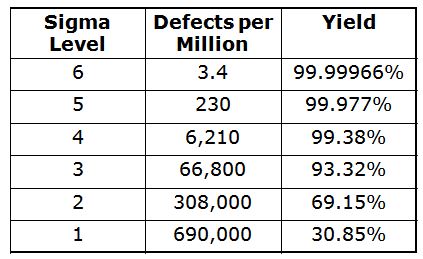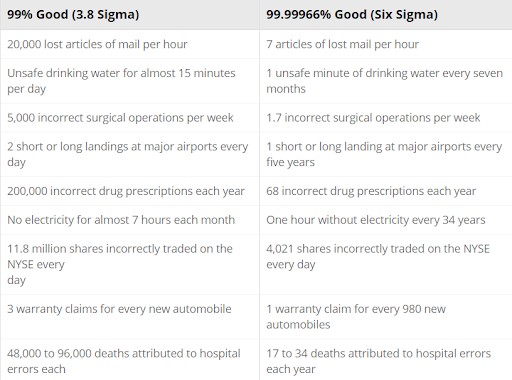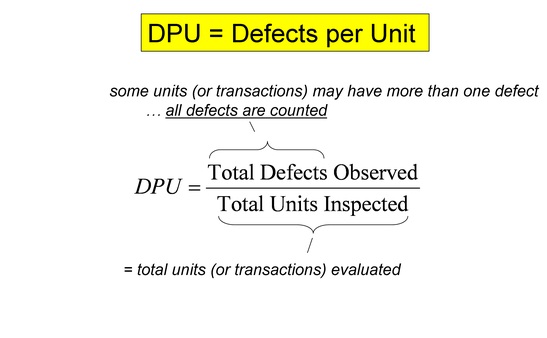6 Lean Six Sigma Calculations You Can Easily Nail With a Bootcamp
The term Six Sigma derives from the statistical basis of the approach and techniques used to tackle quality issues. Six Sigma encompasses the implementation of mathematical formulas and procedures to help organizations in eliminating product variances and discrepancies.
Six Sigma has become an increasingly popular management methodology that uses data to analyze the same, thereby eliminating any defects in the organization’s procedures. Learning Six Sigma calculations can benefit your company in unexpected ways such as:
- Efficient management of time and tracking interruptions
- Reduced cycle time up to 35 percent
- Improved supply chain management by reducing the number of defects in a process
- Higher level of customer satisfaction by analyzing the customer’s perspective and measuring the satisfaction levels
- Maximizing the benefits by continuous quality improvement
Six Sigma, which started on the manufacturing floor at Motorola in the 1980s is now an integral part of operations in every industry, ranging from health care, IT, manufacturing to banking and hospitality. Some of the well-known organizations using the principles of Six Sigma include Amazon, the United States Army, Credit Suisse, General Electronics, Ford Motor Company, and Sears among many others. _11zon.jpg)
Source: Pinterest
Six Sigma is a set of tools, techniques, and procedures organizations use to improve production processes, eliminate defects, and guarantee high-quality. Lean Six Sigma certification assists in validating professionals who can identify risks, errors, and defects in a process and remove them.
The purpose of Lean Six Sigma calculations is to optimize productivity in processes, for example, by quickly rectifying discrepancies. Various Six Sigma calculations formulas come in handy when organizations gather data and start making calculations. Let’s understand Lean Six Sigma calculations in detail.
What Are Lean Six Sigma Calculations?
Organizations have different priorities depending on their specific business goals such as streamlining business procedures, minimizing expenditures, eliminating waste, meeting deadlines, and optimizing connectivity among many others. These tasks lead to the successful accomplishment of projects when executed in the right manner.
Performing Lean Six Sigma calculations in Excel is extremely easy since there is no need to use a calculator. For any Six Sigma student or practitioner, it’s crucial to understand how to do Six Sigma calculations.
Source: LeanSixSigmaDefinition
According to Six Sigma, a production process must create fewer than 3.44 defects per 1,000,000 opportunities to attain the ideal Six Sigma level. All the organizations irrespective of their size or intricacy have identified the perks of aiming for the Six Sigma goal. Even if the company never attains a Six Sigma level, the process of working toward the goal brings dramatic transitions.
If any company is running a Six Sigma process, that means it has eliminated almost all the discrepancies. However, usually, the processes don’t run on Six Sigma, and they operate at Five Sigma or Four Sigma or even lower, which means that the losses they suffer due to inadequate product quality cost them approximately 10 percent to 15 percent of their profits. But a business running Six Sigma makes substantial savings.
You must compute a Sigma process rating to evaluate whether a processing capacity correlates with the specific process requirements. To determine the Sigma process rating, you must calculate the total number of opportunities, the total number of discrepancies, and the defect rate.
A defect is something beyond end-user requirements. However, the opportunities are the total number of possibilities for failures. According to the Sigma Process Table, the Six Sigma rating may yield 99.99966 percent and the percentage of products or services lacking any discrepancies is the yield.
Why Are Six Sigma Calculations Important?
Loopholes in manufacturing and organizational processes are like cancer for any business and Lean Six Sigma calculations prevent this from spreading throughout your business and protect you from heavy losses.
Six Sigma calculations help facilitate quality control and error control. In the absence of these metrics, a business starts from behind due to defects in its processes.
Source: Dummies
Six Sigma methodologies look for perfection in business processes roughly 3.4 discrepancies per million. Six Sigma procedures depend on various factors such as:
1. Skillful decisions about the quality of the manufactured product
2. Processes used to produce the end product
Lean Six Sigma calculations help in quality and error control by providing a universal measure of how well a process performs in comparison to its specific requirements. The higher the Lean Six Sigma score, the more efficient the process.
Let’s assume a critical characteristic is defective 31 percent of the time. You can conclude that it operates at Two Sigma, but if the same characteristic runs at 93.3 percent, then it’s running at Three Sigma.
When a part of a process runs at Three Sigma, the disparities in its performance go beyond the acceptable levels 6.7 percent of the time. It might be an invoicing process that runs longer than an organization’s permissible time limit. Irrespective of the type of crucial part, if it’s Three Sigma, it is faulty 6.7 percent of the time or 66,700 times out of a million.
The organizations using Six Sigma calculations have observed that when they try to have each business process, including the service, the product, and the transaction, operate at Six Sigma, the likelihood of the individual processes being inaccurate was less than 3.4 defects per million opportunities.
When long-term consequences automatically penetrate individual characteristics of a process, the performance of the overall system stays high. These organizations then discovered a method for competing in the dynamic global market which is why the sixth level is an extraordinary number.
Why Six Sigma and Not Five or Four Sigma?
The design of the intricate products for which the Six Sigma project calculations concept had sufficient segments rolled out at the same time and ample long-term degradation that only six would justify. Four or Five Sigma couldn’t give adequate relief from these two limitations.
Source: Dummies
The service sector and transactional organizations’ environments and systems are usually less complex and don’t have many crucial characteristics coming at the same time so they are not embracing Six Sigma. They don’t necessarily have individual characteristics functioning at Six Sigma because in such cases even Four of Five may work.
Specifically, when the process involves human life or safety many outstanding organizations can attain Six Sigma quality in their transactions, services, and end products. For example, when you fly you are 2000 times more likely to arrive at your destination than your luggage. It is because baggage reliability operates at approximately Four Sigma, but airline safety functions at a magnitude higher than Six Sigma.
6 Crucial Lean Six Sigma Calculations You Can Learn with a Bootcamp
Organizations hire Six Sigma professionals because they have in-depth expertise in process optimization techniques crucial for the evolution of business procedures.
Joining a Lean Six Sigma bootcamp provides professionals with an edge over non-certified job seekers. Globally, Six Sigma certifications allow you to step up the career ladder. They validate in a way that the individual knows the basic Six Sigma principles. Going a step further, we will explore six crucial Lean Six Sigma calculations you can learn with a bootcamp.
1. Defects/Discrepancies
A defect is an organization’s failure to meet customers’ specific requirements.
2. Defect vs. Defectives
A nonconformity is a “defect” and a unit having a defect or a set of defects is “defective.”
3. DPU/Defects Per Unit
DPU or Defects Per Unit is the average number of discrepancies identified at the time of population sampling.
DPU = Defects/Total number of units
Let’s understand DPU with the help of an example.
Defects = 15
Units = 500
DPU = 15/500 = 0.03
Source: TheBlogSpotBlog
4. DPO/Defects Per Opportunity
DPO is a metric pointing out the total number of defects in every unit.
DPO = Defects/(Total number of units * opportunities per unit)
Assume:
Defects = 15
Opportunity Per Unit = 5
Units = 500
Total Number of Opportunities = 500*5 = 2500
DPO = (15/2500) = 0.006
5. DPMO/Defects Per Million Opportunities
DPMO is the calculation of the number of errors taking place in an organizational process or business. A process can have several probabilities for inaccuracies per occurrence.
DPMO = Defects Total number of units opportunities per unit 106
Let’s take an example to understand better:
Defects = 15
Opportunity Per Unit = 5
Units = 500
Total Opportunities = 500*5 = 2500
DPMO = (15/2500)*106 = 6000
6. Yield
Yield is the percentage of accomplished commitments over the total number of opportunities.
Yield = 1 DPO
For example:
Defects = 15
Opportunity Per Unit = 5
Units = 500
Total Opportunities = 500*5 = 2500
DPO = (15/2500) = 0.006
Yield = 1 - 0.006 = 0.994
What Are Some Examples of Six Sigma Calculations?
Assume that a project is based on a billing system and the team wants to send accurate bills to the customers. For achieving this process, the team has an opportunity to determine whether the bill is correct or not. With regard to intricacy, all the bills are similar. So, the team took a sample of 300 bills and discovered 70 discrepancies..jpg)
Source: SlideShare
Total Number of Defects: 60
Total Number of Units: 250
Total Number of Defect Opportunities per Unit: 1
DPU (Defects Total Number of Units)
DPU = 76/250= 0.24
DPO (Defects Total Number of Units)
DPO = Opportunities per unit = 60/(2501) = 0.24
DPMO (Defects Per Million Opportunities)
DPMO = DPO 106 = 0.24106 = 240,000
Yield:
Yield = 1 - DPO = 1-0.24 = 0.76
According to the Process Sigma Table, the procedures the team is applying have a sigma rating between 2 to 3. The higher the sigma degree, the lower the number of faults.
Conclusion
Having expertise in cost savings calculations tools in Six Sigma helps professionals get the best jobs in the market. Primarily, this demand for Six Sigma certified professionals is because of their ability to help organizations achieve high-quality output and a higher ROI.
Companies classify their employees based on the hierarchy for training them in different Lean Six Sigma training programs which start from Yellow Belt and progress to Green Belt, Black Belt, Master Black Belt, and finally Six Sigma Champion.
To gain a comprehensive understanding of which Lean Six Sigma course could benefit you the most, check out GreyCampus, the leading provider of Lean Six Sigma training. By enrolling with GreyCampus, you can become eligible for advanced Lean Six Sigma certifications and enjoy a lucrative career.
Want To Crack Six Sigma Certification? Consider Joining a Bootcamp Today!